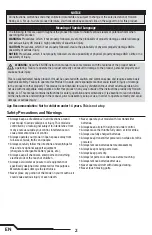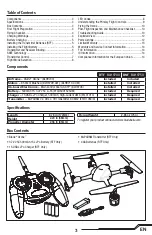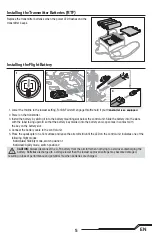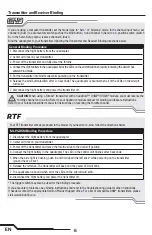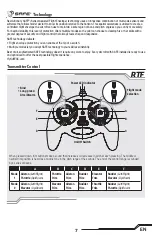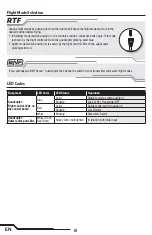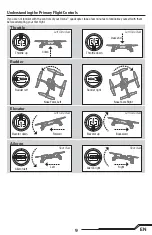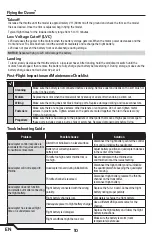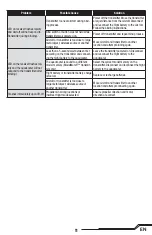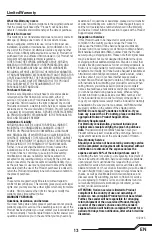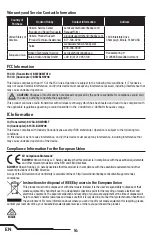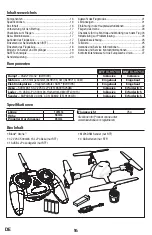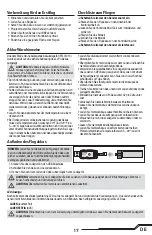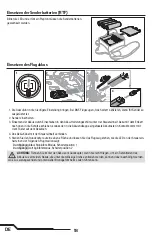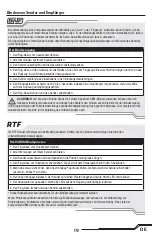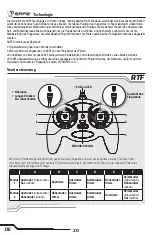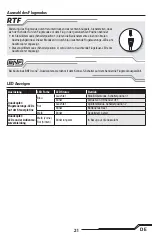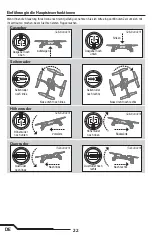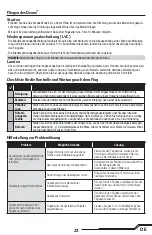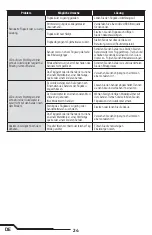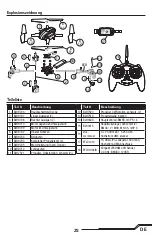
10
EN
Post-Flight Inspection and Maintenance Checklist
√
Cleaning
Make sure the battery is not connected before cleaning. Remove dust and debris with a soft brush or
a dry, lint-free cloth.
Motors
Replace the motor when the model will not fl y steady or veers off when doing a climb out.
Wiring
Make sure the wiring does not block moving parts. Replace damaged wiring and loose connectors.
Fasteners
Make sure there are no loose screws, other fasteners or connectors. Do not over-tighten metal
screws in plastic parts. Tighten screws so the parts are mated together, then turn the screw only
1/8th of a turn more.
Propellers
Make sure there is no damage to the propellers or other parts that move at high speed. Damage to
these parts includes cracks, burrs, chips or scratches. Replace damaged parts before fl ying.
Troubleshooting Guide
Problem
Possible Cause
Solution
Quadcopter control response is
inconsistent or requires extra trim
to neutralize movement.
Aircraft not initialized on a level surface.
Disconnect the fl ight battery, center the control
trim and re-initialize the quadcopter.
Battery not correctly placed in
battery slot.
Adjust battery position so quadcopter balances
in the center of the frame.
Quadcopter will not respond to
throttle.
Throttle too high and/or throttle trim is
too high.
Reset controls with the throttle stick
and throttle trim at the lowest setting.
Quadcopter moved during initialization.
Disconnect the flight battery and re-initialize
the quadcopter while keeping the quadcopter
from moving.
Throttle channel is reversed.
Disconnect fl ight battery, reverse the throttle
channel on the transmitter,
recconnect fl ight battery.
Quadcopter does not function
and smells burnt after connecting
the fl ight battery.
Flight battery connected with the wrong
polarity.
Replace the 5-in-1 board. Connect the fl ight
battery noting proper polarity.
Quadcopter has reduced fl ight
time or is underpowered.
Flight battery charge is low.
Completely recharge the fl ight battery.
Inadequate power to fl ight battery charger.
Use a different USB power source for the
charger.
Flight battery is damaged.
Replace the fl ight battery and follow the fl ight
battery instructions.
Flight conditions might be too cold.
Make sure the battery is warm (room
temperature) before use.
Takeoff
Increase the throttle until the model is approximately 2 ft. (600mm) off the ground and check the trim so the model
fl ies as desired. Once the trim is adjusted, begin fl ying the model.
Typical fl ight times for the included battery range from 5 to 10 minutes.
Low Voltage Cutoff (LVC)
LVC decreases the power to the motors when the battery voltage gets low. When the motor power decreases and the
front and rear FC LEDs fl ash red, land the aircraft immediately and recharge the fl ight battery.
LVC does not prevent the battery from over-discharge during storage.
NOTICE:
Repeated fl ying to LVC will damage the battery.
Landing
To land, slowly decrease the throttle while in a low-level hover. After landing, hold the arm/disarm switch until the
motors have stopped, then remove the battery. Fully charge your battery before storing it. During storage, make sure the
battery charge does not fall below 3V per cell.
Flying the Ozone
™


